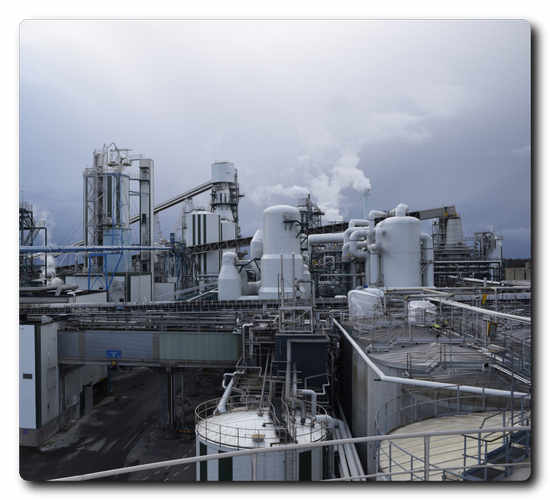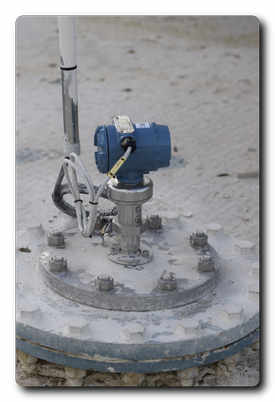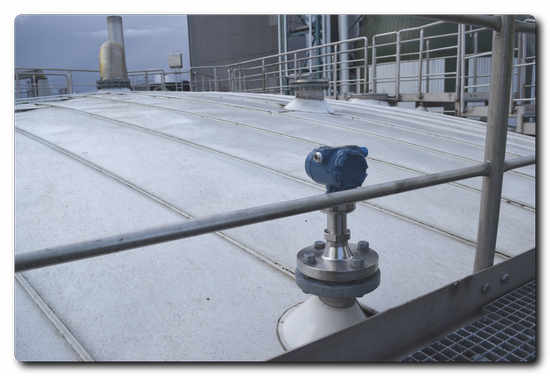The severe operating conditions commonly encountered in pulp mills can prove challenging for level measurement instrumentation. Ingemar Serneby, of Emerson Automation Solutions, explains how the latest non-contacting radar transmitters meet these challenges and provide an accurate and reliable solution.
The various stages of the pulp production process involve a broad range of applications in which accurate and reliable level measurements are essential. These measurements play a crucial role in reducing chemical use, product variability and energy costs; optimising production and storage efficiency; and increasing plant and worker safety. However, the severe operating conditions commonly encountered in pulp mills can prove challenging for most level measurement technologies. Common measurement challenges include turbulence, foaming surfaces, corrosive chemicals, condensation, viscous materials, density and pressure variability, high temperatures, dust generation, and media with a low dielectric constant. It is therefore essential for companies to select instrumentation that can best overcome these challenges to provide the high degree of level measurement certainty they require.
Measurement technologies
Various technologies can be employed to monitor and measure the level of fluids and solids. The most basic method is the manual process of viewing the medium through a sight glass. Other traditional techniques include electro-mechanical devices such as floats and displacer switches, capacitance point level switches, ultrasonic technology, differential pressure sensors, laser-based devices and load cells. In pulp mills, however, these methods are increasingly being replaced by modern electronic technologies such as vibrating fork level switches, guided wave radar (GWR) transmitters, non-contacting radar transmitters and acoustic scanners. These advanced devices provide enhanced functionality and increased diagnostics capability, leading to improved measurement accuracy and repeatability, reduced maintenance requirements and lifecycle costs, and greater reliability.
 Södra Cell mill, in Värö, Sweden, solved two demanding level measurement challenges by installing advanced non-contacting radar transmitters from Emerson.
Södra Cell mill, in Värö, Sweden, solved two demanding level measurement challenges by installing advanced non-contacting radar transmitters from Emerson.
Non-contacting radar
Non-contacting radar technology provides a top-down, direct measurement of the distance to the surface, which is highly accurate and reliable and can be used with liquids, sludges, slurries and some solids. With built-in diagnostics, a lack of moving parts, and straightforward installation and commissioning, non-contact radar transmitters provide both ease-of-use and low maintenance requirements.
To perform continuous level measurements, non-contacting radar transmitters use one of two main modulation techniques – either pulse or frequency modulated continuous wave (FMCW). In pulse systems, thousands of short radar pulses are emitted from an antenna positioned at the tank top directly towards the material below. These pulses are reflected back to the transmitter from the material’s surface. The transmitter measures the time delay between the transmitted and received echo signal, and an onboard microprocessor calculates the distance to the material’s surface, and consequently the level measurement.
Transmitters using FMCW technology transmit a radar signal with increasing frequency over time to create a signal sweep. The signal echo reflected from the surface is picked up by the antenna. Because the frequency of the transmitted signal constantly varies, the echo frequency always differs slightly from the transmitted signal at any given moment. The difference between these frequencies is directly proportional to the distance from the transmitter to the surface, thereby enabling the level to be measured.
Radar transmitters based on FMCW technology have more than 30 times higher sensitivity than devices using pulsed technology, which maximises their signal strength and enables them to deliver greater measurement accuracy and reliability. As a result, they are regarded as the most stable measurement technique available, and are becoming widely adopted throughout the manufacturing and process industries.
 A Rosemount 5408 Non-Contacting Radar Level Transmitter installed on the lime silo.However, FMCW technology has traditionally used more electrical energy than pulse and has thus been deployed only within four-wire radar transmitters. Installing four-wire devices can involve implementing additional cable infrastructure, which is costly and time-consuming, thus limiting the applications in which FMCW transmitters have been used. However, the improved energy efficiency of the latest FMCW devices allows power and communication to be provided by two wires, which eliminates the need for extra infrastructure, enables quick installation and reduces costs.
A Rosemount 5408 Non-Contacting Radar Level Transmitter installed on the lime silo.However, FMCW technology has traditionally used more electrical energy than pulse and has thus been deployed only within four-wire radar transmitters. Installing four-wire devices can involve implementing additional cable infrastructure, which is costly and time-consuming, thus limiting the applications in which FMCW transmitters have been used. However, the improved energy efficiency of the latest FMCW devices allows power and communication to be provided by two wires, which eliminates the need for extra infrastructure, enables quick installation and reduces costs.
Although level measurement technology selection is very much application-dependent, non-contacting radar transmitters provide a broad range of important benefits that enable them to meet many of the toughest challenges presented during pulp production.
Turbulence and foaming
In mixing and blending applications in pulp mills, surface turbulence and foaming liquids are among the most common challenges that level measurement instrumentation needs to overcome. Heavy turbulence or a large amount of foam can affect the signal strength of non-contacting radar transmitters. However, recent advancements in this technology include dedicated software algorithms that counteract the effects of turbulence and surface foaming. Alternatively, devices can operate in bypass chambers or stilling wells to negate these problems.
Corrosive media and condensation
The chemicals commonly used in pulp mills present another challenge for level measurement instrumentation, and devices must be designed to cope with this type of aggressive media. The latest non-contacting radar devices overcome this challenge by incorporating an all-PTFE process seal antenna, engineered specifically to maximise resistance to corrosive chemicals and high condensation levels.
Coating, viscosity and dirty antennas
Pulp applications can involve fluids that coat or stick to some level measurement instruments, but non-contacting radar transmitters are unaffected by coating and viscosity since they do not come into contact with the process media. However, a device’s antenna can become dirty and this can affect its performance. The latest radar transmitters can detect a dirty antenna via signal quality metric diagnostics. This enables preventative maintenance to be scheduled, thereby avoiding process upsets or shutdowns, reducing costs, and increasing reliability, safety and efficiency.
Density, temperature and pressure
In the reactor vessels used in pulp mills, the density of liquids can change as part of the reaction, while extreme temperatures and variable pressures are commonplace. All these factors can affect the performance of level measurement technologies. Non-contacting radar transmitters are a suitable solution in these applications as they do not need to compensate for density changes, and their measurement accuracy is not affected by high temperatures or pressure changes.
Solids measurement
Measuring the level of solids and powders – in lime silos, for instance – presents various challenges, the most fundamental of which is the uneven nature of the material surface. The peaks and troughs of uneven surfaces deflect energy away from a radar signal and can generate false signal reflections that affect measurement accuracy. By using a signal processing algorithm that merges surface peaks, the latest radar transmitters based on FMCW technology are able to overcome this challenge and provide a high degree of accuracy, even with rapid changes in level.
Dust generation
The considerable amount of dust generated in pulp production can affect the performance of level measurement technology. Non-contacting radar transmitters usually handle dust well, but a heavy layer can clog the antenna and block the signal. The latest devices overcome this issue with an integrated air purging system that cleans the antenna, thereby preventing signal loss and maintaining measurement accuracy.
Dielectric constant
When measuring media with a low dielectric constant – such as the lime powder used in pulp production – much of the radiated energy from pulse radar transmitters is lost, leaving very little energy to be reflected back. However, the superior sensitivity of non-contacting radar transmitters based on FMCW technology maximises their signal strength and enables them to accurately and reliably measure low dielectric media.
Södra Cell mill, Värö, Sweden
Typical examples of how advanced non-contacting radar technology is helping pulp producers to meet their toughest level measurement challenges can be seen at the Södra Cell mill, in Värö, Sweden. The mill is one of the world’s most modern pulp production facilities, producing around 700,000 tons of high-quality, chlorine-free softwood pulp and 1.6 TWh of energy annually. The company was facing two demanding level measurement challenges, which it solved by installing advanced non-contacting radar transmitters from Emerson.
The first challenging application required the level measurement of very fine lime powder stored in silos that are 27 metres high. As the powder piles up inside the silos, the material tends to form in towers beneath the inlet, producing an uneven surface. In addition, the powder covers everything with a fine layer that is prone to build-up, making it difficult to measure the level with any degree of accuracy. Other challenging factors include the long distance to be measured and the powder’s low dielectric constant.

Södra had tried using mechanical devices, ultrasonic technology and radars, but their performance was affected by clogging. With the majority of non-contacting radar devices, the signals are very low, which makes them unreliable. However, the company found a solution by installing Rosemount™ 5408 Non-Contacting Radar Level Transmitters with parabolic antennas.
The Rosemount 5408 uses FMCW technology, and its increased sensitivity allows it to successfully measure lime powder, despite its low dielectric constant. The parabolic antenna’s built-in air purging adapter prevents the lime powder from building up. To ensure accurate measurement, the Rosemount 5408 uses special software algorithms specifically designed to handle the characteristics of solids.
Since being installed, the Rosemount 5408 has proved to be extremely reliable, despite the dusty conditions. This has resulted in less maintenance being required and a reduction in downtime, leading to improved productivity.
Södra also needed to find a better way of measuring the level in mixing tanks containing a mixture of lye and soap. The media is aggressive and contaminating, with a dense, thick layer of foam forming on its surface, making it a very demanding environment for level measurement technology. The company had tried using a number of different technologies to accurately and reliably measure the level in these 18-metre tanks. However, mechanical devices experienced problems caused by build-up, while the nozzle of GWR transmitters proved to be too narrow, causing measurement errors whenever the probe came close to the nozzle.
Due to the problem with build-up, Södra required a measurement solution that was resistant to the media, and therefore installed Rosemount 5408 Non-Contacting Radar Level Transmitters with PTFE process seal antennas. The superior sensitivity and advanced software functions of the Rosemount 5408 enable it to accurately measure through foam, even when the surface is turbulent. The transmitter’s signal quality measurement functionality is able to detect abnormal process conditions such as antenna coating, while its PTFE process seal prevents the media from building up on the transmitter, thereby maintaining an accurate and reliable measurement.
Since integrating the Rosemount 5408 into the distributed control system at the mill, Södra has been delighted with the positive results. These include significantly reduced maintenance and downtime, and an increase in productivity.
To learn more about Emerson’s Rosemount 5408 Non-Contacting Radar Level Transmitter, visit www.Emerson.com/rosemount5408
